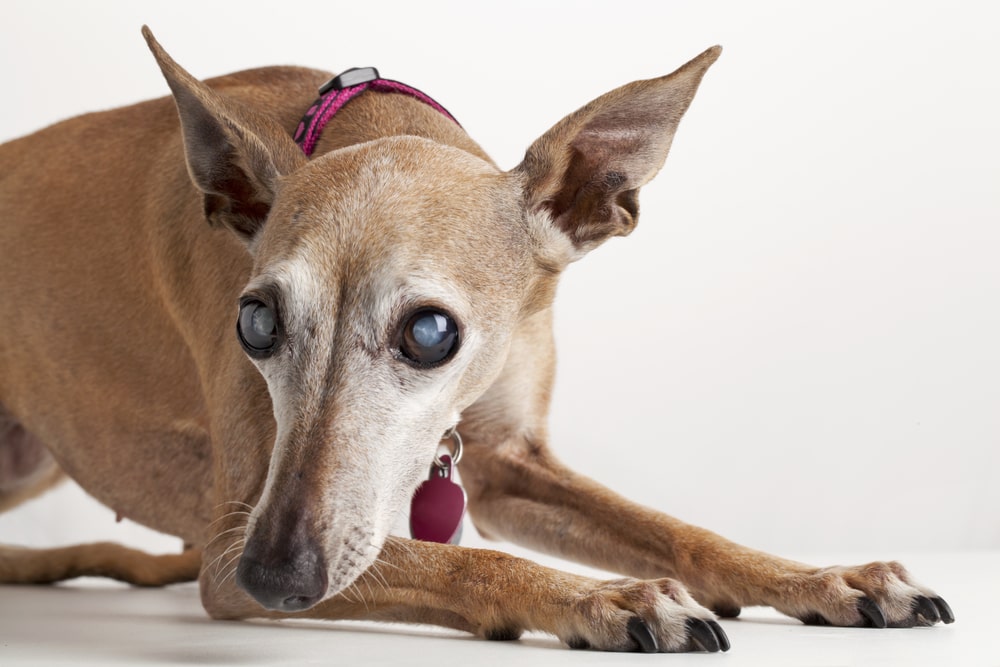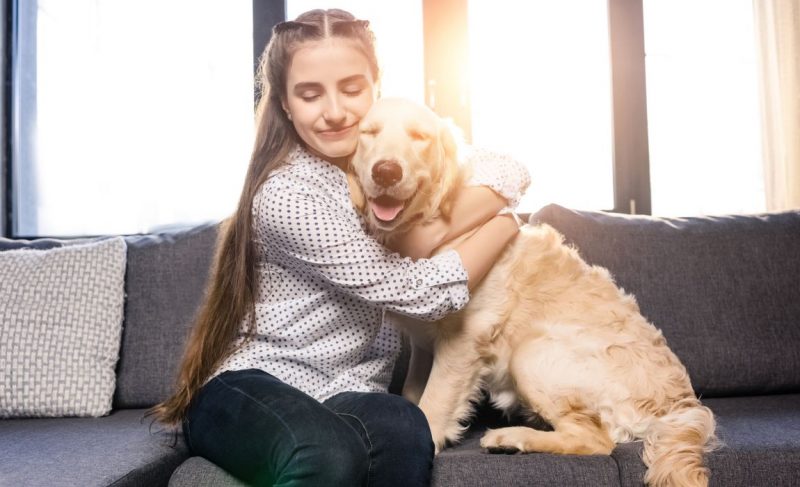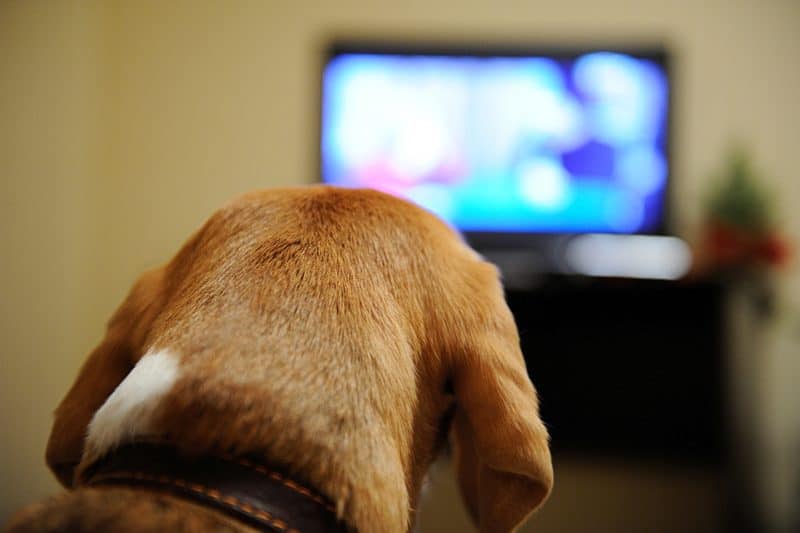It’s been said that a dog is a man’s best friend, and it’s certainly no surprise that most dog owners work hard to keep their pets healthy and happy.
Yearly check-ups at the vet, supplying them with nutritious dog treats and high-grade food are only a few ways dog owners accomplish this. In addition, many pet owners work diligently to provide their furry friends with adequate physical exercise and mental stimulation.
But even the most dedicated dog owners can sometimes find themselves having to deal with life-changing illnesses affecting their pet.
Dogs can develop a vast array of diseases, cancers, and medical problems over the years. One common health issue among canines is blindness, particularly among older dogs.
Environmental influences and inherited traits passed down through the dog’s DNA are what causes blindness. In either case, it’s important that pet owners be informed of the most common issues associated with blindness so they can be prepared to help their best friend should they ever become afflicted.
The most common causes of canine blindness are listed below and include both symptoms to watch out for and clinically-proven best practices for care. Plus, we’ll also include recommend toys and products for blind dogs, as well as how to find out if your dog is blind.
Common Causes of Canine Blindness
1. Cataracts
Cataracts are defined as cloudiness occurring in the lens of the eye. They can result as little more than a slight visual impairment or cause complete blindness.
Some dog cataract symptoms to look out for include:
- A visual cloudiness present in your dog’s eye(s)
- Difficulty seeing or bumping into objects in dimly lit settings
- Increased thirst and urination
- Weight loss (in some cases)
Cataracts are developed due to a variety of reasons, including diabetes, old age, inflammation of the eye, low calcium levels in the blood, exposure to some insecticides, and radiation poisoning.
Cataract-Prone Breeds: The most common breeds that inherit cataracts include miniature poodles, miniature schnauzers, golden retrievers, Boston terriers, American cocker spaniels, and Siberian Huskies.
Vet Treatment for Canine Cataracts: A visit to the vet will quickly determine whether your furry pal has cataracts. In addition, the vet will probably attempt to diagnose any conditions, such as diabetes, that are known to accompanying canine blindness. He or she will then treat your dog for both illnesses.
Treatment may include emulsification of the eye’s lens, medicine to prevent infection and pain, or surgery. If your pet requires surgery, in the US you can expect to pay anywhere from $2,000 to $3,000 on average to have their cataracts treated.
During dog cataract surgery, your dog will be placed under anesthesia and the cloudy lens replaced with an artificial lens to restore vision. While anesthesia does have its risks, in many situations it’s worth it as cataracts can sometimes be treated to reverse blindness completely or prevent any further vision loss.
2. Diabetes
Diabetes is a common disease that affects as many as 10% of dogs worldwide.
Diabetes itself can cause infections that result in partial or full blindness in pets. Some symptoms of low blood sugar in dogs include:
- Shaking
- Weakness
- Loss of consciousness
- Confusion
- Seizures
If your dog is exhibiting any of these symptoms, it’s important to take them to the vet immediately. When diabetes is diagnosed early on, many canines will go on to live long, happy lives by adhering to the right treatments.
Frequently, dogs with diabetes develop eye-related medical problems like glaucoma or cataracts.
Diabetes-Prone Dog Breeds: The dog breeds most often diagnosed with diabetes are miniature poodles, Bichon Frises, pugs, dachshunds, miniature schnauzers, terriers, and beagles. It’s also important to note that female dogs of any breed are at a higher risk of developing diabetes when pregnant or in heat.
Vet Treatments For Diabetes: Besides treating the dog for blindness-causing illnesses that may complement diabetes, your vet will also treat the diabetes itself. This may include regular insulin injections, oral medication, specialized diet plans for diabetic dogs, and exercise routines.
Should your dog have diabetes it’s important that you tell any guests visiting your home that treats and table food is absolutely banned. Even the smallest dose of sugar could cause your pet to go into diabetic shock, have a seizure, go into a coma, or die.
3. Glaucoma
Glaucoma is a painful disease caused when fluid cannot properly drain from the eye. It can be temporary or permanent, depending on the severity of the damage to the optic nerve.
It is a rapidly progressing condition that typically results in blindness within the first year of diagnosis.
Symptoms commonly associated with dog glaucoma include:
- Frequent blinking
- Redness in the whites of the eye
- Cloudiness or dilated pupil
- Impaired vision
Additionally, there may also be a change in attitude or appetite.
Typically, glaucoma is caused by inflammation or injury to the eye. Secondary causes include diabetes, an immune defense reaction to bacteria, and hereditary factors.
Glaucoma-Prone Dog Breeds: Canine glaucoma is most often found in breeds like chow chows, Siberian huskies, poodles, and cocker spaniels. With all breeds, however, it’s most common among older dogs.
Veterinarian Treatments For Dog Glaucoma: The conventional treatment for dogs facing glaucoma is a prescription medication to lower the pressure of the fluid behind the eye — although the vet may also prescribe medications to reduce the chance of infection. If the nerve is damaged beyond repair, your vet may suggest surgery to replace the optic nerve and repair eyesight. In the most severe cases, the eye may need to be removed to prevent further fluid buildup.
4. SARDS
SARDS is an abbreviation of a condition known as Sudden Acquired Retinal Degeneration Syndrome. This syndrome often starts with the dog bumping into objects in familiar areas, such as the backyard.
They tend to have slow reactions to movement as well and exhibit signs of dehydration, including drinking water in increasingly larger amounts and frequent urination. Some dog owners have also reported weight gain and changes in eating habits.
Although scientists and veterinarians agree the cause of the blindness is in the retina, there is no definitive cause associated with SARDS. Some believe the issue is immune-related while others suspect allergic reactions to be the cause.
SARDS-Prone Dog Breeds: Dog owners of dachshunds and miniature schnauzers may be shocked to learn these breeds are the two most commonly afflicted by SARDS. Other breeds frequently affected include pugs, spaniels, and Maltese terriers. Further, as many as 60-70% of dogs diagnosed with Sudden Acquired Retinal Degeneration Syndrome are female. It is most often found in older canines with an average age of approximately 8.5 years.
Treatments For Dog SARDS: There is no cure, treatment, or prevention method currently known for SARDS, but dogs who have it tend to live fairly normal lives. For this to happen, owners of SARDS-afflicted dogs simply need to ensure their dog can easily navigate through familiar surroundings at home.
Also, providing guidance when out of the house and speaking in a calming, low tone may help with anxiety or restlessness felt by dogs who have been blinded by SARDS.
5. Age
Senior dogs may face blindness from various causes including cataracts, glaucoma, and other reasons listed in this article. As a dog ages, much like humans their body slows down and begins to weaken. If your senior dog has been checked by a vet and shows no other symptoms of illness, he or she may simply be suffering vision loss due to old age.
Your dog may show symptoms like:
- Dizziness
- Energy loss
- Bumping into furniture in familiar rooms
- Signs of depression or attitude change
The best way to help your dog navigate through old age is to be a companion to him or her. Continue with all the exercise and activities your dog typically finds fun and exciting.
In addition, giving your pet lots of attention and love, especially when in unfamiliar places, can provide them with some much-needed comfort.
Another useful option is to keep your dog safe by practicing non-visual cues and commands. Using your voice and gentle leash tugs can help your dog learn how to maneuver around obstacles when going for walks outside.
6. Breeds
Some dog breeds are more predisposed to blindness than others. This includes:
- English Springer Spaniels
- Siberian Huskies
- Poodles
- Collies
- Boston Terriers
- Great Danes
- German Shepherds
- Short-nosed Breeds (ex. bulldogs, beagles, St. Bernard’s, and shar-peis)
While the majority of these breeds are faced with vision impairment due to having developed blindness-causing illnesses, some face additional challenges. For example:
- Collie breeds have a specific illness called Collie Eye Anomaly, or CEA for short. When a dog is affected, this genetic condition can range in severity from no vision impairment at all to total blindness.
- Short-nosed breeds, including Boston terriers, are prone to Cherry Eye, a condition caused by the tear gland protruding outward, revealing a red and round eye. These breeds often require surgery to re-adjust the gland back into place.
- German Shepherds are the most common breed to develop Chronic Superficial Keratitis. This is caused when the corneas are inflamed, causing vision impairment and blindness.
- Great Danes also are prone to entropion, or an eyelid that has rolled inward. This condition is painful and serious, as the corneal surface is often damaged from abrasion by the eyelashes. The good news is that it usually can be treated through surgery.
Depending on the severity of the condition, your vet may be able to treat or even cure some of these breed-specific conditions. However, some, like CEA and Chronic Superficial Keratitis, are permanently debilitating.
Blind Dog Products: Gear For Visually-Impaired Dogs
Some things you might consider getting for your blind dogs:
- Halo Dog Bumper. The Halo Dog Bumper is a headband that wraps around your dog’s head and is secured to a harness-style vest. The idea is that, when you dog gets close to bumping into a wall or object, the halo will give off tension, indicating to your dog that he’s hit an object. Many dogs adapt really well to the Halo bumper, and it can be a great tool for helping dogs get used to the layout of their home without eyesight.
- Dog Gates. Dog gates or baby gates can be used to section off your dog from dangerous parts of your house (such as stairs or decks).
- Baby Bumpers. Baby bumpers (or bubble wrap) can be used to soften hard table edges or other sharp objects that could hurt your pooch.
- Dog Camera. You may want to consider purchasing a treat-dispensing dog camera that and can be used to monitor and interact with your dog while you’re away. The Furbo pet camera allows you to be notified when your dog is barking, as well as talk to him through the two-way microphone and dispense treats to engage and interact with him via your smartphone!
- Chew Toys. Your dog doesn’t need to see well to enjoy chewing, so grab him a good chew toy and watch him go! Chew toys can also maintain your dog’s dental health, so they’re smart to have around.
- Treat-Dispensing Toys. Many toys are designed to dispense treats when your dog nuzzles or paws at them. These toys are can help keep your dog engaged and happy, even without eyesight. Just make sure you start off with easy challenge toys so that your dog doesn’t get frustrated too quickly. If you have a blind dog, also make sure to check out our article on the best dog toys for blind dogs!
- Essential Oils. Help your dog navigate by sound and scent by using essential oils in certain areas of the house – for example, place a drop of lavender on your dog’s bed, and a drop of orange near the backdoor, etc. Only use a tiny bit, as your dog’s sense of smell if so strong that more could overwhelm him.
- Blind Dog Vest. This won’t be necessary for all owners, but some may choose to outfit their dog with a vest indicating that they are blind. This can help remind strangers to approach carefully and slowly.
We also have an entire article on great dog toys for blind dogs, so make sure to check that out for more fun stuff designed for visually-impaired pooches.
Dog Blindness Test: How to Tell If Your Dog is Blind
Wondering if your dog is blind or becoming blind? There are a few ways you can evaluate your dog’s vision.
The easiest ways to evaluate your dog’s vision is simply to consider what behavior has been normal for them in the past, compared to their current behavior. Are they bumping into objects when they haven’t previously? Are they relying more in smell vs sight? At what distance can your dog recognize a familiar dog or human?
You can also evaluate your dog’s vision with a few of the tests we’ve added below. And of course, if you suspect your dog is blind, take them to the vet to confirm for sure!
1. Obstacle Course
The first way you can evaluate your dog’s vision is by having your pooch navigate an obstacle course. You can so this using a dog agility course in your backyard, or simply by positioning household objects in a certain way that requires your dog to go around them.
For example, you could place a chair and step stool in a narrow hallway, and go to the end to cheer your dog on and encourage him to go through the pathway you’ve set up. Watch for any hesitation your dog shows – and of course physically bumping into obstacles is a big red flag.
You don’t even need to create a special obstacle course – try simple repositioning furniture around the house and see how your dog navigates it. Most dogs can remember how their house is set up, so they might not normally have trouble navigating various rooms. However, if you switch up the position of the furniture and your dog starts bumping into things, you can bet something is up.
Having your dog navigate stairs is also a good tool for evaluating vision. If your dog has navigated stairs without issue in the past, encourage him to go down a few (perhaps a small number of steps at the front door or back porch). If your dog shows a lot of fear or hesitation (when previously he had no issues), his vision may be deteriorating
It’s also worth noting that most dogs have more trouble at night, when there is not as much light. If you suspect your dog is losing his vision, try repositioning furniture in the evening and keep close watch on your pet’s night-time maneuvering.
2. Menace Response
Both dogs and humans have natural responses that force us to shut our eyes when an object comes into close contact with our faces.
Bringing an object quickly towards your dogs eyes should invoke a blinking response from your dog. If he doesn’t blink, there may be a problem.
Of course be careful to not hit or injure your dog during this test! You’ll also want to conduct this test in a room with normal lighting.
3. Pupillary Light Reflex (PLR)
Take a flashlight and shine it about 1-2 inches from your dog’s eye. How does the pupil respond? In a normal dog (and human), the pupil will contract (get smaller) when it is hit by the light.
When you shut off the flashlight, your dog’s pupil should grow (aka dilate) to take in more light.
If you shine the flashlight onto your dog’s eye and see that the pupil stays dilated (aka large) instead of contracting, this is an indicator that your dog is suffering from vision issues.
Another easy test you can do with a flashlight is to simply turn on the light quickly and shine it at your dog’s face. Your dog should instinctually blink if his eyes are working properly.
Also take a look at your dog’s eye and see if you can locate any fuzziness or blurred areas. These are also key indicators of vision issues.
4. Movement Test
In a well-lit area, cover one of your dog’s eyes and drop a cotton ball about 6 inches away from the dog.
Normally, your dog should react by tracking the cotton ball with his eye. Repeat the test while covering the other eye to help identify if only one or both eyes are deteriorating.
If your dog is having trouble focusing, you might also try this test using a treat. Try to drop the treat on carpet so that it does not make a noise – we need to make sure your dog is using his eyes!
Now of course your dog will be able to smell the treat, but you should still be able to observe his eyes visually tracking the treat’s movement if his eyesight is working properly. No visually-healthy dog will pass up the chance to stare down a treat!
Naturally, if your dog seems to be having vision issues based on these tests, go see your vet ASAP!
Leaving a Blind Dog Alone Safely
It can be a little nerve-wracking leaving your blind dog alone, but many dogs can adjust to limited vision with your help.
Don’t forget, dogs rely heavily on their sense of smell already, and with a bit of time, they’ll get used to navigating without much (or any) eyesight.
However, there are some things you can do to make your blind dog’s life eaiser, including:
- Don’t move the furniture. Your dog will create a mental map of your home, so try to avoid moving around the furniture. While relocating the furniture for testing your dog’s vision (as detailed below) makes sense, once you know your dog has vision problems, it’s best to keep furniture where it is.
- Push chairs in when you get up. Try avoid leaving chair pulled out at a dining table or desk – pushing the chair fully towards a table or desk will prevent your pooch from bumping into an obtruding object.
- Tape down or relocate cords. You don’t want to have may cords over your house that your dog could trip on. Either relocate the cords or cover and tape them securely to the floor.
- Secure sharp corners. Just as you need to baby-proof your home with toddlers, it makes sense to dog-proof your home when you have a visually-impaired pooch. Consider taping or bubble wrapping sharp corners (like those on a coffee table). Or opt for baby bumpers!
- Give your dog a safe space. While not all dogs are fans of crates, many dogs are comforted by having a space to call their own where they can feel safe and cozy. Consider getting your dog a comfy crate to hang out in.
- Don’t move your dog’s food and water bowls. It’s best to limit relocating anything your dog needs access to, such as food and water bowls. Your dog knows where those things are now – so it’s best to simply keep them there! Consider replacing your dog’ traditional water bowl with a water fountain – not only will your dog’s water be fresher, but the sound of the fountain can be an auditory aid in helping your dog locate his feeding area. You also might consider creating a designated toy box near your dog’s crate or bowls so that he can easily find his favorite toys when he wants them!
- Use sound to help your dog. When you’re away, consider keeping the radio on, while it emits sound from an ongoing location. Your dog can use his ears to understand where he is in location to the sound. This is helpful for outdoors too – you may want to install a wind chime near your door so that your dog can easily get back to the house by listening for the chimes.
- Use different textured rugs or carpets. Put textured mats or rugs in various areas to help serve as tactile identifiers (for example, you could use a weaved mat at the front door and a silicon mat near your dog’s feeding bowl).
- Isolate dangerous areas. When your dog begins to lose his vision, it may be time to gate off certain problematic areas if your home. You can use baby gates or indoor dog gates to keep your dog contained only in safe areas of the house. Many owners choose to gate off stairways, steps, and balconies.
- Pet sitters / visitors. Consider having a pet sitter stop in during the day to check on your blind dog and give him a little attention. Services like Rover make it easy for you to find someone in your area who can stop by and cuddle with your canine.
- Give your dog stuff to do! Just because your dog is blind or going blind doesn’t mean he wants to sit around all day doing nothing! Set up dog treasure hunts by hiding bones or frozen Kongs around the house (just make sure you’re putting them in safe areas you dog can access fairly easily). Puzzle toys and chew toys are also a great way to stimulate your dog while you are away.
Blind Dog Anxiety: Tips For Alleviating Anxiety
It’s very normal for dogs who have lost their eyesight or are in the process of losing their eyesight to become anxious. After all, it’s pretty scary when you stop seeing!
Much of what we discussed above will help alleviate your dog’s anxiety – such as not moving furniture and using smell and auditory-based queues to help your dog figure out where he is.
Other strategies include:
- Walk familiar paths. New areas may start to make your dog more nervous, so it’s best to stick to well-trodden familiar walking routes. Keep an eye on your path and stay off of uneven or rough terrain.
- Heel or loose-leash training. With your dog’s vision failing, you want to teach your dog to not walk so far ahead of you. Consider teaching your dog to loose leash walk or brush up on the heel command to keep your dog closer to you.
- Opt for a handle harness. You may want to consider using a lift harness for your dog that features a prominent handle. This will make it easier for you to help your dog navigate around objects or aid him when hopping into the car.
- Work on the “wait” command. Since your dog can’t see for himself, it’s smart to work on your verbal commands and queues. Teach your dog that “wait” indicates upcoming obstacles. “Going up” and “going down” can also be helpful for getting in and out of the car.
- Warn strangers about your dog’s condition. This is especially important if your dog is anxious around strangers. Let visitors, strangers, and other dog owners know that your dog is blind and that they should approach very slowly (or not at all). Many dogs get grumpier in their old age, and going blind doesn’t help this. If your dog doesn’t want to go say hi to other dogs, that’s fine!
Blindness can be a scary health concern for both the dog and the pet owner. Navigating through all the unknown causes and treatments can confuse owners just looking for the best option to help their best friend.
It may be comforting to know many dog owners contend blindness hasn’t reduced their pet’s quality of life. In fact, when properly diagnosed and treated, most dogs with vision impairment live long, happy lives.
Have you ever had a blind dog? What are your tips for managing your dog’s blindness? Share your thoughts in the comments!








Leave a Comment